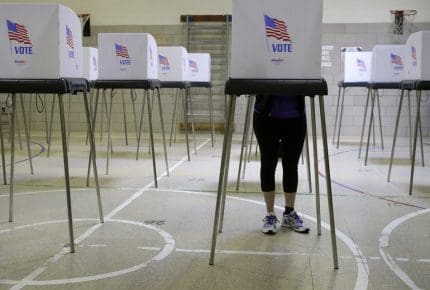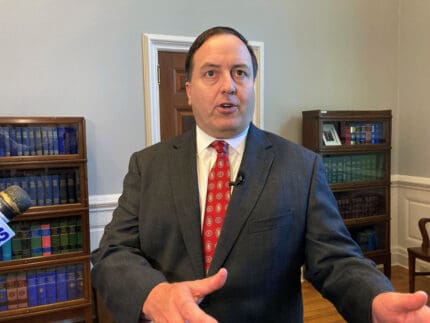Telehealth abortions on the rise since Dobbs, new report shows
Researchers studying national abortion trends found that in the 15 months since Roe v. Wade fell, abortion rates remained elevated despite more limited access throughout the U.S., according to the Society of Family Planning’s latest #WeCount report published Wednesday.

Researchers studying national abortion trends found that in the 15 months since Roe v. Wade fell, abortion rates remained elevated despite more limited access throughout the U.S., according to the Society of Family Planning’s latest #WeCount report published Wednesday.
Partially explaining this is a rise in people having abortions via telemedicine, Ushma Upadhyay, co-chair of #WeCount, told States Newsroom. Before Dobbs, about 4% of total recorded abortions were via telehealth abortion; that rose to 16%, as of September 2023.
“Telehealth abortion has really had a huge impact,” said Upadhyay, a professor at the University of California, San Francisco’s Advancing New Standards in Reproductive Health. “We’re addressing unmet need that existed in those states, even before Dobbs. I think that a lot of the unmet need in the blue states is being met, as well as people traveling from states with abortion bans.”
In the nation overall between July and September 2023, there were between 81,000 and 89,000 abortions monthly, numbers that are slightly smaller than in the previous report covering April through June 2023, but higher than in the months leading up to the Dobbs v. Jackson Women’s Health Organization decision.
“Some of the volume may also be due to reductions of barriers to abortion care, including increased financial support for low-income abortion seekers, reduced burden of cost and travel by use of telehealth, and improved access via care navigation from practical support groups and public health departments,” the report reads.
However, researchers estimate that in the 14 states with total abortion bans, there were approximately 120,000 fewer abortions compared to before Dobbs.
“People in states with abortion bans or severe restrictions were forced to delay their abortions, to travel to another state, to obtain care from a provider in a shield law state, to self-manage their abortions, or to continue a pregnancy they did not want,” the report reads.
Upadhyay said the recent small increases over the months does not compensate for the declines in banned states.
“Whenever we publish these numbers, we have to publish whatever we find,” she said. “But it is one of our worries that people will think, ‘Oh, there’s no longer a problem.’ We know that there are thousands of people living in states with abortion bans that continue to not be able to access abortion.”
States with the largest declines in 15 months were Texas (46,200), Georgia (24,640), Tennessee (17,545), Louisiana (11,465), and Alabama (9,525). Researchers saw the largest surges in Illinois (28,665), Florida (15,155), and California (12,515). Numbers in Wisconsin have fluctuated dramatically with its fluctuating abortion legality. Before Dobbs the state saw approximately 600 abortions per month, which dropped to fewer than 10 per month after Dobbs. Researchers recorded 50 abortions in Wisconsin in September 2023, shortly after providers resumed providing abortions following a court decision.
Though the majority were in-clinic abortions, Upadhyay believes the rate of telehealth abortions is likely to rise. There were a reported 14,110 telehealth abortions in July 2023, 14,060 in August, and 13,770 in September, according to the report, which includes in this tally abortions via telehealth provided by brick-and-mortar clinics and virtual-only providers, including those operating in the five states (Colorado, Massachusetts, New York, Vermont, and Washington) that in 2023 started providing abortion care under shield laws to patients from states with abortion restrictions.
The #WeCount team plans to finish collecting state-by-state data as part of this project through December 2024. Among the data’s limitations, it doesn’t not include self-managed abortions.
Recommended

U.S. House Speaker Johnson says IVF should be protected — just not by Congress
U.S. House Speaker Mike Johnson said Thursday that it’s up to states and not Congress to preserve access to in vitro fertilization, weighing in on a growing national debate and campaign issue.
By Jennifer Shutt, States Newsroom - March 14, 2024
Biden calls for expanded child tax credit, taxes on wealthy in $7.2 trillion budget plan
President Joe Biden released his budget request for the upcoming fiscal year Monday, calling on Congress to stick to the spending agreement brokered last year and to revamp tax laws so that the “wealthy pay their fair share.”
By Jennifer Shutt, States Newsroom - March 11, 2024
Human, financial costs of gun violence are growing dramatically, health care group says
Last week’s mass shooting amid a Kansas City Super Bowl parade was another reminder that despite claims that more guns make us safer, actual experience shows the opposite to be the case.
By Marty Schladen, Ohio Capital Journal - February 20, 2024










































































